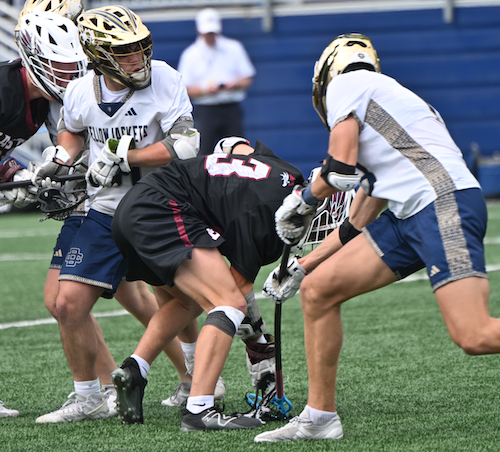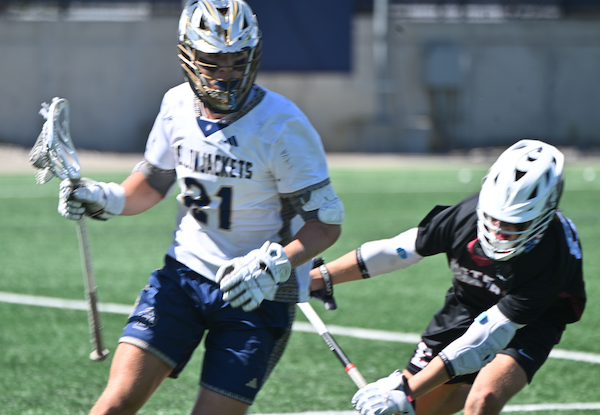
Casting Lines for Future Tournaments
August 12, 2016
By Jack Roberts
MHSAA Executive Director
The MHSAA is best known to the public for the tournaments it conducts to conclude the fall, winter and spring seasons each school year.
These tournaments, the first and largest program of the MHSAA, have survived the Vietnam War, the Korean conflict and two World Wars. They have survived the technology bubble, the housing collapse, the energy crisis and the Great Depression.
MHSAA tournaments existed at the dawn of aviation and at the time of our nation’s lunar landing. Popes, presidents and governors have changed and changed again and again, and MHSAA tournaments roll on year after year.
But the sense of tradition and permanence and inevitability of MHSAA tournaments doesn’t dissuade us from asking questions about our tournaments, even some of the most basic questions. Here are two.
Question #1
I have long been and will always be an advocate for a Ryder Cup format for the MHSAA Golf Finals, and a team tennis approach to the MHSAA Tennis Finals; but 90 years of tradition is hard to overcome. Might this be a more exciting format? Could it be co-ed? Could it reverse the decline in boys tennis participation, and increase girls golf participation? Wouldn’t it be fun to try?
Periodically, the International Olympic Committee requires each of the designated Olympic sports to defend its status, to state its case why the sport should remain a part of the Olympic program. Then, after a series or votes that retain one sport at a time, the IOC drops the sport that makes the weakest case. It does so to make room for one of the previously unlisted sports that makes the best case for inclusion.
This would appear to keep the existing Olympic sports on their toes, and to keep the Olympic movement fresh and reflective of modern trends in sports.
While I would not enjoy the controversy, I can see the potential for some positive results if the MHSAA were to invoke the same policy for determining the 14 tournaments it will provide for girls and the 14 for boys.
This might cause us to consider more deeply what a high school sport should look like, or at least what an MHSAA tournament sport should stand for.
On the one hand, we might be inclined to drop tournaments for those sports that involve mostly non-faculty coaches and non-school venues, or require cooperative programs to generate enough participants to support a team, or resort almost entirely to non-school funding, or cater to individuals more than teams.
Or perhaps this process would cause policymakers to forget traditional thinking and ask: “In this day and age, should we shake off traditional notions of sport and consider more where modern kids are coming from?” That might mean fewer team sports and more individual sports, more “extreme” sports like snowboarding and skateboarding, and more lifetime sports, meaning not just golf and tennis and running sports, but also fishing and even shooting sports.
Currently, MHSAA policy states that the MHSAA will consider sponsorship of a tournament series for any sport which 64 member schools conduct on an interscholastic basis as a result of action by the governing boards of those schools.
Should the only question be how many schools sponsor a sport, or must an activity also have certain qualities and/or avoid certain “defects?” What should an MHSAA tournament sport look like and stand for?
Question #2
Bristling from criticism that his association is a money-grabbing exploiter of children, my counterpart in another state said, “If we were running our programs just to make money, we would do very many things very differently.” I knew exactly what he meant.
Because we care about the health and welfare of students, because we mean what we say that the athletic program needs to maximize the ways it enhances the school experience while minimizing academic conflicts, and because we try to model our claim that no sport is a minor sport when it comes to its potential to teach young people life lessons, we operate our programs in ways that make promoters, marketers and business entrepreneurs laugh, cry or cringe.
If money were the only object, we would seed and select sites to assure the teams that attracted the most spectators had the best chance to advance in our tournaments, regardless of the travel for any team or its fan base. If money were the only object, we would never schedule two tournaments to overlap and compete for public attention, much less tolerate three or four overlapping events. If money were the only object, we would allow signage like NASCAR events and promotions like minor league baseball games.
Those approaches to event sponsorship may not be all wrong; they’re just not all right for us. And we will live with the consequences of our belief system.
During a typical school year, more than 20 percent of the MHSAA’s 2,097 District, Regional and Final tournaments lose money. Not a single site in golf, skiing or tennis makes a single penny. In no sport did every District, Regional and Final site have revenue in excess of direct expenses.
In fact, in only three sports – boys and girls basketball and football – is revenue so much greater than direct expenses overall that it helps to pay for all the other tournaments in which the MHSAA invests.
That’s right: invests. When we present our budget to our board, we talk about the MHSAA’s investment in providing tournament opportunities in all those sports and all those places that cannot sustain the cost of those events on their own. How much is this investment worth to students, schools and society?
These two are core questions that require our focus far in advance of talk about scheduling, site selection, seeding and the myriad matters that too often hijack our time and attention.

Country Day Scores in Record-Setting Fashion to Claim 1st Title Since 2014
By
Drew Ellis
Special for MHSAA.com
June 8, 2024
ANN ARBOR – Heading into Saturday’s MHSAA Division 2 Final, Detroit Country Day coach Chris Garland attributed a lack of offense to why his Yellowjackets came up short in the 2022 and 2023 championship games.
That issue was corrected this time around.
Detroit Country Day put up the second-most goals in D2 Finals history, defeating Ada Forest Hills Eastern 18-7 to claim its first championship since 2014 and fourth overall.
“We have so many skilled players. We are a complete team with tremendous depth,” Garland said of the offense. “We just want to keep putting the ball in the hands of our offense. If you stop one of them, we have another guy that can come at you. We showed that (Saturday).”
One player that Forest Hills Eastern didn’t have an answer for was Country Day sophomore Keaton Yearego. He matched a MHSAA Finals record with six goals, three coming during a 5-0 rally in the second period that put the Yellowjackets ahead for good at 8-4.
 “I have a lot of confidence in my team, and my coaches have a lot of confidence in me and allow me to play my game,” Yearego said. “I have some great senior attackmen around me that help me do my thing. Today was just my day.”
“I have a lot of confidence in my team, and my coaches have a lot of confidence in me and allow me to play my game,” Yearego said. “I have some great senior attackmen around me that help me do my thing. Today was just my day.”
The Hawks (16-5) tried to set the tone early, posting the first two goals of the game when junior Jackson Arnold and senior Will Morgan each found the net during the opening minutes.
“I loved the energy. The boys came out to play right from the get-go,” Forest Hills Eastern coach Antonio Boggiano said. “We knew right away that we weren’t happy just getting to this moment. We actually wanted to compete for the championship.”
The Yellowjackets (19-2) didn’t let the early deficit affect them and answered with three straight goals, two coming from senior Oliver Aaron.
“We’ve faced that kind of challenge before. It’s nothing new for us. We’re a resilient team,” Aaron said. “When you have a strong bond with your teammates and can rely on them, you can bounce back from those slow starts.”
The Hawks answered with the last goal of the first period from junior Bradyn Campbell. Senior Preston Hoexum then found the net to open the second to put Forest Hills Eastern up 4-3.
That’s when Country Day got rolling offensively. The Jackets scored 14 of the next 16 goals over 26 minutes of play.
Most of the scores came unassisted, as the Yellowjackets won individual battles to get open looks at the net.
 “We have a lot of offensive threats on our team, so if one way isn’t working, we know we have other options,” Yearego said. “We really just executed well and showcased how many different ways we can score. It was an unbelievable performance.”
“We have a lot of offensive threats on our team, so if one way isn’t working, we know we have other options,” Yearego said. “We really just executed well and showcased how many different ways we can score. It was an unbelievable performance.”
The offensive dominance showed in a 49-22 shot advantage for Country Day. The score could have been even more in favor of DCD, but Hawks goalie Camden Klaes made 15 saves in net.
Morgan and Campbell both finished with two goals to lead Forest Hills Eastern, which made its first Finals appearance since 2021.
“I’m just proud of the boys, just for overall the season we have had,” Boggiano said. “We met in October and said right then and there that we were going for this ring. We came up a little bit short, but I’m just extremely proud of (the team). They overcame a lot of adversity.”
Aaron finished with four goals for Country Day to go with Yearego’s six. Preston Cook, Caden Daley and Rhys Kenney all found the net twice.
PHOTOS (Top) Country Day goalie Kellen Curby makes a save during Saturday’s Division 2 Final. (Middle) Country Day and Forest Hills Eastern players scramble for the ball. (Below) DCD’s Joe Norton (21) works to get into the open.

